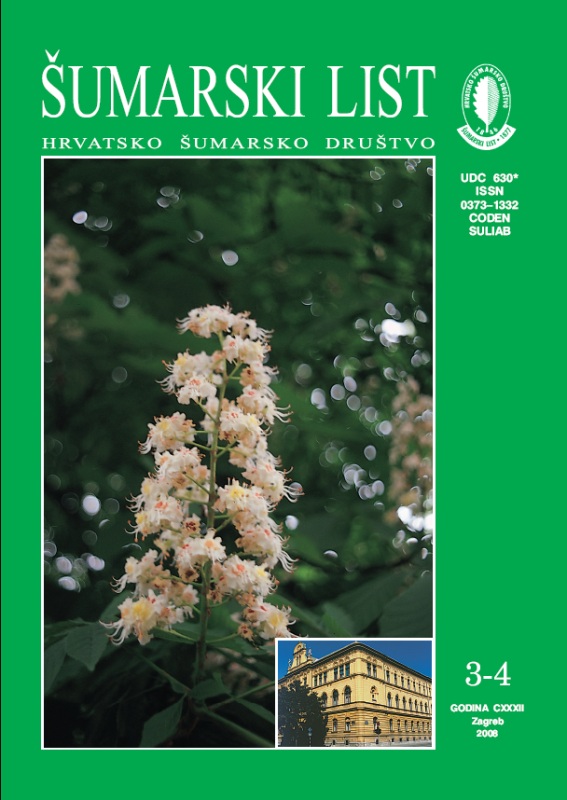| |
| IZVORNI ZNANSTVENI ČLANCI |
| |
|
|
| Idžojtić, M., M. Glavaš, M. Zebec, R. Pernar, Ž. Kušan, Đ. List, M. Grahovac-Tremski | UDK 630* 442 (001) |
| Intensity of Infection with Yellow Mistletoe and White-berried Mistletoe on the Area of the Forest Administrations Zagreb and Koprivnica
pdf
HR
EN
|
107 |
| Goglia, V., J. Žgela, I. Đukić | UDK 630* 304 + 964 (001) |
| The Effectiveness of Anti-Vibration Gloves: Part I
pdf
HR
EN
|
115 |
| |
| PREGLEDNI ČLANCI |
| |
|
|
| Matić, S., D. Delač | UDK 630* 923 + 231 + 242 + 245 |
| Silvicultural Treatments as a Method of Increasing the Value of Private Forests in Gorski Kotar
pdf
HR
EN
|
121 |
| |
| STRUČNI ČLANCI |
| |
|
|
| Grgurević, Dražen | UDK 630* 272 |
| Suzana’s Park
pdf
HR
EN
|
147 |
| Krpan, A. P. B. | UDK 630* 972 |
| University of Zagreb – Faculty of Forestry and Department of Forest Engineering in the Bologna Process
pdf
HR
EN
|
157 |
| Konjević, D., U. Kierdorf, Z. Janicki, A. Slavica, K. Severin | UDK 630* 156 + 132 |
| Red Deer Hummel – a Unique Feature in a Red Deer Stag
pdf
HR
EN
|
171 |
Summary: Occasionally, antlerless red deer stags, showing complete absence of antlers or possessing only antler knobs, can be observed. In the English literature, antlerless red deer stags are referred to as hummels. In this paper we present the case of a red deer hummel shot during the ruting season of 1981, in the area of Sokolovac, Croatia. The stag was aged at 5 years and weighed approximately 200 kg (undressed). The stag possessed only small pedicles and almost completely lacked antlers. Only small knobs of antler bone were present bilaterally. Furthermore, a discrepancy in height between left (length 17 mm) and right (length 35 mm) cranial outgrowth was observed. In the literature, the occurrence of antlerless red deer stags is mainly attributed to under- or malnutrition during the first year of life when pedicle development takes place, and a resulting underdevelopment of the pedicles. Because growth of antlers (at a normal rate) only starts after the pedicles have reached a critical size, insufficient growth of pedicles will result in a completely antlerless condition or, as in the present case, in the formation of only a very small amount of antler bone. However, also other factors could result in insufficient pedicle growth. As pedicle growth depends on androgenic stimulation, low levels of circulating androgens or a low density of androgen receptors in the antlerogenic periosteum could lead to poor pedicle growth and in consequence to a complete or almost complete lack of antler growth.
Key words: antler; incomplete development; pedicle; red deer hummel |



